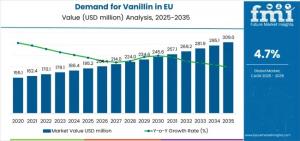EU Vanillin Market Set to Reach USD 309 Million by 2035 — Growth Fueled by Food, Pharma, and Natural Trends
The EU vanillin market is set for steady growth, driven by rising demand in food, beverages, and fragrance industries.
NEWARK, DE, UNITED STATES, November 10, 2025 /EINPresswire.com/ -- The European Union vanillin market is poised for significant expansion, projected to grow from USD 195.2 million in 2025 to approximately USD 309.0 million by 2035, representing an absolute increase of USD 112.4 million over the forecast period, according to Future Market Insights. This growth translates to a total market increase of 57.6%, with a compound annual growth rate (CAGR) of 4.7% from 2025 to 2035.
Vanillin demand in Europe is being propelled by sustained activity in food and beverage manufacturing, growing pharmaceutical applications, and a shift toward natural and clean-label variants. Its versatility in chocolate, confectionery, baked goods, dairy, and beverages, combined with flavor-masking functionality in pharmaceuticals, underscores its continued relevance across industries.
To Explore Detailed Market Data, Segment-Wise Forecasts, and Competitive Insights, Request Sample Report. https://www.futuremarketinsights.com/reports/sample/rep-gb-27144
Market Trends and Forecast Dynamics
Between 2025 and 2030, vanillin sales are expected to rise from USD 195.2 million to USD 245.2 million, contributing 44.5% of the decade’s forecast growth. This phase will be shaped by manufacturers investing in capacity expansion, improving natural vanillin extraction processes, and optimizing synthetic production for cost efficiency.
From 2030 to 2035, the market is projected to grow from USD 245.2 million to USD 307.6 million, accounting for 55.5% of total growth. Key drivers during this period include:
• Accelerated adoption of natural vanillin aligned with clean-label consumer trends.
• Expanding pharmaceutical applications, particularly in taste-masking excipients.
• Innovations in biotechnology-based production, enabling cost-effective natural vanillin alternatives.
Historically, from 2020 to 2025, vanillin demand grew moderately at a CAGR of 4.7%, driven by food and beverage usage, dairy alternatives, functional drinks, and pharmaceutical palatability enhancement.
Drivers of Vanillin Demand in EU
Vanillin continues to dominate due to its cost-effectiveness, flavor reliability, and multifunctional properties. It enhances other flavors, masks undesirable tastes, and remains stable under diverse processing conditions. Large-scale manufacturers depend on synthetic vanillin for consistent quality, while premium segments increasingly prefer natural alternatives.
Segmental Insights
• By Product Type: Synthetic vanillin accounted for 64.5% of EU sales in 2025, projected to decline slightly to 60% by 2035. Its dominance is supported by cost advantages, large-scale production, and consistent quality, while natural vanillin captures growth driven by clean-label trends.
• By Application: Food remains the largest segment, representing 60% of demand in 2025, slightly declining to 55% by 2035 due to faster pharmaceutical growth. Chocolate, confectionery, baked goods, and dairy are key consumption areas. Pharmaceuticals currently account for 15% of sales, rising to 20% by 2035, fueled by taste-masking requirements in pediatric and geriatric formulations.
Regional Market Performance
• Germany: Leads with 29.5% market share, driven by the largest food manufacturing sector and robust pharmaceutical presence.
• France: Holds 23.5% share, supported by confectionery, premium bakery, and pharma applications.
• Italy: Represents 13%, benefiting from chocolate, bakery, and pharma utilization.
• Spain: Contributes 9.5%, expanding through food processing and confectionery development.
• Netherlands: Growing at the fastest CAGR of 5%, leveraging its role as a European ingredient distribution hub and pharmaceutical production center.
• Rest of Europe: Accounts for 18.5%, reflecting steady demand in smaller markets.
Competitive Landscape
The EU vanillin market is moderately fragmented, with competition driven by cost efficiency, technical support, natural vanillin innovation, and distribution reach. Key players include:
• Solvay SA (18% share) – chemical manufacturing expertise, industrial-scale production, reliable supply.
• Borregaard (12%) – lignin-based natural vanillin, renewable chemistry focus.
• Camlin Fine Sciences (10%) – diverse synthetic and natural portfolio, distribution networks.
• Merck Group (8%) – pharmaceutical-grade vanillin, stringent quality standards.
• Prinova Group LLC (7%) – ingredient distribution, technical support.
Other regional producers and distributors collectively hold 45% of the market, serving diverse food and pharma applications across Europe.
Key Market Drivers and Innovations
• Biotechnology-based production methods enabling natural vanillin at competitive costs.
• Clean-label reformulations prioritizing natural ingredients.
• Pharmaceutical formulation requirements emphasizing palatability and regulatory compliance.
• Expanding applications across food, beverage, and pharma sectors.
To Access The Full Market Analysis, Strategic Recommendations, And Analyst Support, Purchase The Complete Report Here. https://www.futuremarketinsights.com/checkout/27144
Outlook
The EU vanillin market is expected to maintain steady growth, driven by a balance of synthetic reliability and natural adoption, supported by technological innovations, evolving consumer preferences, and regulatory oversight. Manufacturers adopting sustainable production, clean-label positioning, and biotech-based approaches are likely to lead the market in the coming decade.
Browse Related Insights
Vanillin Market: https://www.futuremarketinsights.com/reports/vanillin-market
Bio Vanillin Market: https://www.futuremarketinsights.com/reports/bio-vanillin-market
Sudip Saha
Future Market Insights Inc.
+1 347-918-3531
email us here
Legal Disclaimer:
EIN Presswire provides this news content "as is" without warranty of any kind. We do not accept any responsibility or liability for the accuracy, content, images, videos, licenses, completeness, legality, or reliability of the information contained in this article. If you have any complaints or copyright issues related to this article, kindly contact the author above.

